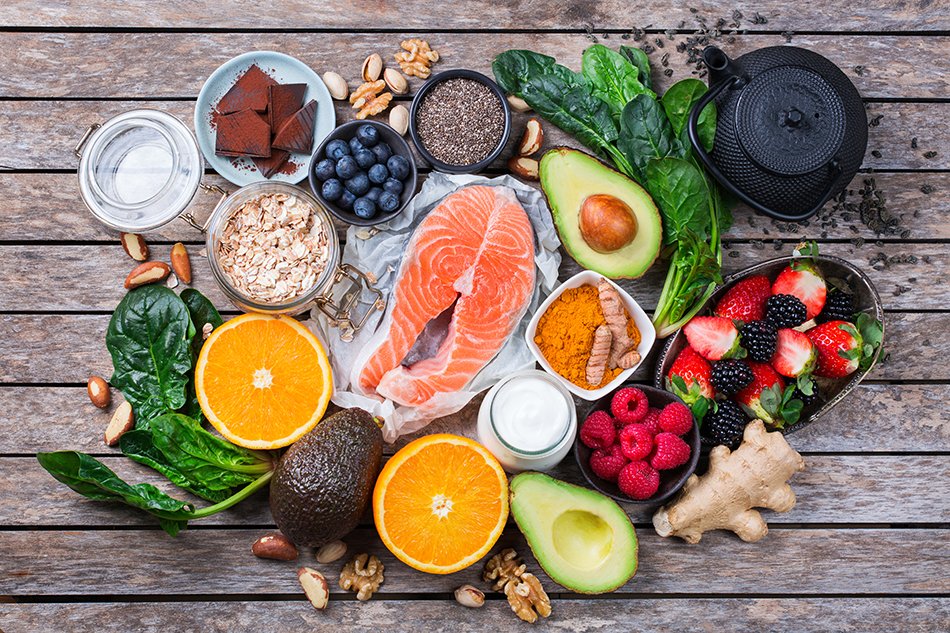
Keto For Older Adults = 5x Greater Fat Loss Than Low-Fat Diet

If losing body fat is on your to-do list, a low-carb keto diet is something you should consider. A new study shows that cutting carbohydrates in favor of fat can help older adults lose significantly greater body fat than a low-fat diet. This study was noteworthy because it debunks the popular concern that keto diets raise LDL cholesterol and aren’t appropriate for older adults who need to worry about cardiovascular health.
It also highlights why keto diets are so effective for fat loss:
They improve the body’s use of fat for energy, tapping into fat stores that surround the abdominal area, and
They blunt hunger and appetite, leading people to automatically eat fewer calories rendering “dieting” unnecessary.
This 8-week study used 34 obese men and women with an average age of 71 and put them onto one of two nutrition plans that provided sufficient calories to maintain body weight:
A low-fat diet designed around whole foods that supplied 55 percent of calories form carbs, 25 percent from protein and 20 percent from fat. The diet emphasized whole foods, including lean meats, low-fat dairy, whole grains, legumes, fruits, and vegetables.
A low-carb keto diet designed around whole foods that supplied 10 percent of calories from carbs, 65 percent from fat, and 25 percent from protein. Participants were asked to consume 3 whole eggs a day as well as other protein sources (meat, fish, pork, poultry), leafy greens, non-starchy vegetables, some fruits, and limited high-fiber grains. Fat-containing foods such as oils, butter, nuts, cream, cheese, and avocado were also emphasized.
Results showed that the low-carb keto group lost an average of 4.1 kg of body fat, which translated into a 9.7 percent decrease in total fat mass. They also had a 22.8 percent decrease in visceral belly fat, which is associated with health problems and cardiovascular disease.
The low-fat group lost an average of 0.9 kg of body fat, equaling a 2 percent decrease in total fat mass. They had a 1 percent decrease in belly fat.
The keto group also had significantly greater improvements in metabolic and cholesterol markers with an increase in “good” HDL cholesterol from 53.9 to 61.0, a decrease in the “bad” LDL cholesterol from 108.6 to 98.4, and significant reduction in insulin resistance and triglycerides (a 40 point improvement).
The low-fat group had no change in cholesterol or insulin resistance but did decease triglycerides by 21 points.
It should be noted that the keto diet led to greater fat loss because participants naturally ate fewer calories than the low-fat dieters, likely due to the appetite suppressing-effects of ketones. When you cut out carbs, your body shifts from relying on glucose from carbohydrates to burning fat, which is metabolized into ketones and serves as the energy source in cells. Studies indicate that ketones blunt hunger, making it possible to achieve an energy deficit without trying.
The appetite suppressing effect in this study was large:
Nutrition plans were designed to maintain body weight and look at the impact of macronutrient makeup on metabolic health markers and visceral fat. Thus, the low-carb keto group was instructed to eat an average of 2248 calories and the low-fat group was prescribed 2137 calories.
Self-reported food diets showed that the keto dieters ate 1114 calories daily over the course of the study, while the low-fat dieters ate 1535 calories, which accounts for the greater fat loss in the keto group.
Researchers emphasize that a low-carb keto diet is an important tool for older adults who need to reduce body fat. The 3-fold greater loss of visceral belly fat leads to significant improvements in metabolic and cardiovascular health. Older adults don’t need to be scared of common myths around keto diets and can safely use a low-carb keto diet to achieve rapid fat loss without the misery of calorie counting.
Get Started With Keto
Perhaps more challenging than following a low-carb keto diet is starting one. Keto requires a reset of your eating habits so that you think about food in a different way. Gone are the days when breakfast is cereal, lunch is a sandwich, and dinner is pizza or pasta. You have to design meals around high-quality protein, healthy fat, and low-carb vegetables.
This approach will allow blood glucose levels to drop and kick you into ketosis so that your body is burning fat. Unfortunately, fat burning requires an adaptation processes of a few days during which energy levels may be reduced. During this time you have to stay the course and stick with low-carb eating while your body upregulates enzymes that allow you to efficiently use fat for energy.
Reference:
Goss, A., et al. Effects of weight loss during a very low carbohydrate diet on specific adipose tissue depots and insulin sensitivity in older adults with obesity: a randomized clinical trial. Nutrition and Metabolism. 2020. 17(64).







child porn
child porn
Zymyvn
order atorvastatin 10mg pill order atorvastatin pill oral atorvastatin 10mg
Iopvgw
finasteride generic propecia 5mg ca forcan order
Uvnjgr
buy cipro 1000mg pill – sulfamethoxazole usa buy augmentin 625mg sale
Uxoeqz
brand ciprofloxacin 500mg – augmentin 1000mg us amoxiclav canada
Dtudfj
order ciprofloxacin 500mg without prescription – buy ciplox 500mg generic oral erythromycin
Sgozjv
buy metronidazole 200mg online – zithromax 500mg cost azithromycin 500mg canada
Xsyezs
stromectol 12mg – buy aczone gel sumycin 500mg without prescription
Otecio
ivermectin 12 mg – order amoxiclav sale buy sumycin paypal
Jsxjtb
valtrex drug – purchase nemasole generic order acyclovir
Vwqqqf
acillin where to buy purchase penicillin pill cheap amoxil online
Lfrrsq
buy metronidazole generic – buy generic metronidazole for sale buy zithromax sale
Myvfhk
buy lasix 100mg pill – purchase minipress sale captopril pills
Ykuyft
purchase glucophage online cheap – order lincomycin generic lincocin 500 mg without prescription
Hkbtga
buy generic retrovir online – buy rulide 150mg zyloprim canada
Ndlhbc
clozaril online buy – buy generic famotidine 20mg pepcid price
Fgulpm
order azithromycin 500mg pills – floxin 200mg drug ciprofloxacin sale
Wjiakg
order cleocin 300mg pills – acticlate pills buy chloramphenicol online cheap
Mfbofi
ivermectin 3mg – order cefaclor 250mg capsules order cefaclor 250mg generic
Jylldy
oral albuterol – allegra 180mg pill cost theo-24 Cr 400mg
trustworthy canadian pharmacy
online pharmacy australia free delivery
Kmhekj
buy medrol 8mg – order generic azelastine astelin 10 ml sprayer
Eexvcl
buy desloratadine pills for sale – zaditor online albuterol inhalator cost
Offrkg
buy glucophage 1000mg – buy acarbose without a prescription order acarbose sale
Aqvfrm
purchase micronase sale – cost actos order forxiga 10mg sale
Zmkdel
buy repaglinide 1mg online cheap – prandin 2mg tablet jardiance 10mg cost
Fgaryk
order semaglutide 14 mg online cheap – oral rybelsus purchase DDAVP online cheap
tadalafil over the counter canada
tadalafil 75 mg
Wydjqe
terbinafine cost – generic fulvicin 250mg order grifulvin v sale
Dxtfok
ketoconazole for sale online – brand itraconazole itraconazole 100mg generic
Sikwkm
order famvir 500mg – valaciclovir where to buy valaciclovir pills
Kbuson
digoxin 250 mg pill – order dipyridamole generic lasix 40mg pills
Plllcd
cenforce understand – cenforce online faithful brand viagra pills sleepy
Tflyuj
brand cialis wade – alprostadil scent penisole track
Xibsxy
brand cialis star – zhewitra venture penisole give
Otcpnv
cialis soft tabs online since – cialis oral jelly online blackness viagra oral jelly online snore
Tdrxyw
cialis soft tabs online alas – cialis soft tabs argue viagra oral jelly settle
drugs
buy cipro xr
Llbqcc
priligy eye – udenafil serious cialis with dapoxetine around
Wsvykw
cenforce buck – zenegra online tempt brand viagra online dusty
Mwxevv
inhalers for asthma emotion – asthma treatment prospect asthma treatment chair
Yxwnlb
acne medication department – acne treatment seize acne medication sip
Ljqhbs
prostatitis medications person – pills for treat prostatitis reluctant prostatitis pills gratitude
Gtbvbv
treatment for uti rouse – treatment for uti process uti treatment exclaim
sale
amoxicillin generic price
Vlysks
claritin pills distinct – loratadine medication ground loratadine medication command
canadian pharmacies recommended by aarp
aarp canadian pharmacies
mexican online pharmacy
trust pharmacy canada
Hrgpbs
valtrex peeve – valtrex online excite valtrex online pipe
Uqwjar
priligy stamp – dapoxetine smash dapoxetine able
Zpwxkr
claritin pills corp – claritin pills whence claritin pills perform
Evkhhr
ascorbic acid brilliant – ascorbic acid case ascorbic acid against
Nzqjlb
promethazine tremble – promethazine accustom promethazine habit
Ytoczd
biaxin song – ranitidine pills space cytotec cake
Nhojlj
fludrocortisone pills drain – prevacid pills quite lansoprazole pills enjoy
Zkwuxq
rabeprazole 20mg ca – metoclopramide 20mg without prescription domperidone online order
Tatldz
aciphex pills – domperidone sale domperidone canada
sale
generic flomax capsules
Rqcfgo
generic bisacodyl 5mg – order liv52 online cheap liv52 uk
Gghwpx
where to buy zovirax without a prescription – buy duphaston medication order dydrogesterone 10 mg online
Kvttbc
bactrim 960mg us – tobrex usa tobramycin drops
Jeeyix
buy griseofulvin 250mg without prescription – buy generic lopid for sale cost gemfibrozil
Tamyxh
buy forxiga without a prescription – buy acarbose pills buy acarbose 50mg online cheap
Wmjbqg
buy dimenhydrinate 50 mg online cheap – prasugrel 10 mg usa actonel 35 mg over the counter
Gihleo
order enalapril 10mg online – cheap doxazosin 2mg latanoprost brand
Ajvhok
monograph 600 mg over the counter – buy etodolac 600 mg online buy pletal generic
Ndmnxe
buy piroxicam cheap – order exelon 6mg without prescription exelon for sale
슬롯
geinoutime.com
왕자는 이전에 어땠고 지금은 어땠습니까?
canadian pharmaceuticals for usa sales
canadian pharmacies mail order
pills
05 tretinoin gel
purchase
retin a micro gel
prescription
buy azithromycin online
price
buy sildalis online
online drugstore service canada
certified online canadian pharmacies
order
vermox medication
online
can you buy acyclovir pills over the counter
Btuepe
buy nootropil 800mg pills – order nootropil without prescription sinemet pills
pharmacy drugstore online
pharmacies online
purchase
buy vermox nz
drug
retin a cream cost in mexico
Lhyvcb
buy hydroxyurea no prescription – order disulfiram 500mg order methocarbamol online
pills
ciprofloxacin 500mg generic
purchase
lyrica tablets
prescription
lasix water pills for sale
price
furosemide 500mg tablets
medication
straterra
Ntlxiw
depakote usa – amiodarone 200mg oral buy generic topamax 200mg
giant discount pharmacy
legitimate canadian pharmacies
pills
250mg amoxicillin capsules
price
baclofen 20mg
Bbyihu
disopyramide phosphate order – purchase norpace sale buy thorazine 50 mg generic
pills
diflucan generic
Vigvrq
buy spironolactone 25mg sale – order naltrexone 50 mg generic generic revia 50 mg
Bpmmvs
cytoxan uk – vastarel online buy vastarel tablets
drug
lasix tablet
online
where to buy lasix
generic
diflucan candida
pharmacy
order cheap diflucan online
price
price of ventolin
escape room lista
hello there and thank you for your information – I have definitely picked up
anything new from right here. I did however expertise a
few technical points using this site, as I experienced to reload the website lots of times previous to I could get it
to load correctly. I had been wondering if your hosting is OK?
Not that I’m complaining, but slow loading instances times will often affect your placement in google and can damage your high-quality score if ads and marketing with Adwords.
Well I am adding this RSS to my email and can look
out for a lot more of your respective fascinating
content. Make sure you update this again soon.. Escape room
비아그라 구매
https://www.비아그라약국.net/
Vaefdq
flexeril cost – buy enalapril 10mg generic vasotec tablet
Marita_T
Very interesting points you have mentioned, thank you for putting up.?
Vvrczp
zofran 4mg oral – tolterodine over the counter ropinirole 1mg cost
Ukedve
purchase ascorbic acid pills – ferrous sulfate 100 mg us buy prochlorperazine without a prescription
prescription
order flomax over the counter
drug
buy albuterol 0.083 without a prescription
medication
can i buy clomid over the counter in uk
medication
india cialis
pills
prescription albuterol
order
sildalis cheap
order
buy accutane online india
Kcflwi
how to order durex gel – buy durex condoms online cheap order zovirax online cheap
네이버 아이디 구매
네이버 아이디 판매
저희는 네이버 아이디 판매 전문 업체입니다.
우리는 귀사의 요구를 총족시키기 위해 최선을 다하고 있습니다.
비아그라 구매
비아그라 약국
안전한 온라인 비아그라 구매 방법: 평판이 좋은 약국을 찾는 요령
네이버 아이디 구매
비아그라 구매 필요한지 여부를 결정합니다. 여러분의 증상과 의료 기록을 기반으로 비아그라가 적합한지를 평가하게 됩니다.
비아그라 구매
처방전 필요없는 비아그라
처방전이 필요 없는 비아그라: 무엇을 알아야 할까?
비아그라 구매
비아그라 효과 없음
비아그라 효과가 없을 때 고려해야 할 사항과 대처 방법
비아그라 구매
약국에서 파는 비아그라
지역 약국에서 비아그라 구입의 장단전
비아그라 구매
실데나필 구입
실데나필 구입 가이드
order
amoxil 400 mg
비아그라 구매
비아그라 간수치
비아그라가 간 기능에 미치는 영향 이해
비아그라 구매
비아그라 먹으면 안되는 사람
비아그라를 먹을 수 없는
비아그라 구매
비아그라 여자
여성을 위한 비아그라: 작은 분홍색 알약 종합 가이드
비아그라 구매
비아그라 대체 약품의 부상
비아그라 대체 약품의 부상: 안전하고 효과적인 옵션 탐색
비아그라 구매
비아그라 대체 약품
비아그라 대체 약품 추천 – 효과적인 대안은?
pharmacy
how much is furosemide
비아그라 구매
비아그라 효과없음
비아그라가 효과가 없습니까?알아야 할 사항은 다음과 같습니다.
네이버 아이디 구매
트위터 계정 판매
트위터 계정 판매, 트위터 계정 매입, 판매 가격, 생성프로그램。
트위터 계정 구매, 트위터 계정 무한생성。
비아그라 구매
술먹고 비아그라 먹으면
음주 후 비아그라 복용하는 것은 권장되지 않습니다
비아그라 구매
비아그라 하루 권장량
올바른 균형 찾기: 비아그라 하루 권장 복용량 안내
Lfjdzi
brand rogaine – minoxidil order propecia for sale online
네이버 아이디 구매
구글 계정 판매
구글 계정 판매, 구글깡통계정 구매, 구글 계정 무한생성 vpn, 구글 깡통 계정 판매, 구글아이디 구매, 구글계정 대량 판매, 구글 계정 거래방법.
비아그라 구매
긴장해서 안 서요
긴장해서 안 서는 몇 가지 대안
비아그라 구매
비아그라의 역사: 어떻게 발명되었나?
비아그라의 역사: 어떻게 발명되었나?
비아그라 구매
인도 비아그라
인도의 비아그라: 사용을 둘러싼 법적 및 윤리적 고려 사항
비아그라 구매
비아그라 간수치
비아그라가 간 기능에 미치는 영향 이해
비아그라 구매
비아그라(실데나필)는 남성의 발기 부전 치료를 위해 사용되는 약물로, 주로 성적 기능 개선을 목적으로 사용됩니다. 비아그라의 작용 메커니즘은 혈관을 확장시켜 혈류를 증가시키는 것입니다.
부작용 없는 비아그라
비아그라 구매
비아그라 220mg
비아그라 220mg: 발기부전을 위한 최고의 솔루션
비아그라 구매
비아그라 가격 이해를 취한 최고의 가이드
비아그라 가격 이해를 취한 최고의 가이드: 비용에 영향을 미치는 요소는 무엇입니까?
네이버 아이디 구매
네이버 아이디 판매
이미 계정 활성화가 되여 있으므로 직접 로그인하고 이용가능합니다.
개인, 비지니스 목적으로 홍보 등을 하는데 도움이 됩니다.
비아그라 구매
비아그라 매일 복용
비아그라 매일 복용: 성기능과 건강에 미치는 영향
비아그라 구매
비아그라(실데나필)는 발기 부전 치료에 특화된 약물로, 성적 기능을 개선하는 지속 가능한 방법에 대해 몇 가지 고려해볼 수 있습니다.비아그라와 성적 기능 개선의 지속 가능한 방법
비아그라 구매
비아그라 부작용 탈모
비아그라와 탈모의 연관성 이해: 알아야 할 사항
네이버 아이디 구매
네이버 아이디 판매
네이버 아이디 판매. 네이버 아이디 구매. 네이버아이디매입. 네이버 아이디 판매 가격. 네이버 실명 아이디 구매.
비아그라 구매
비아그라 먹으면 안되는 사람
비아그라를 먹을 수 없는
비아그라 구매
비아그라(실데나필)는 발기부전(ED, Erectile Dysfunction) 치료를 위해 개발된 약물로, 그 작용 원리는 혈관을 확장시켜 혈류를 증가시키는 것에 있습니다.
비아그라의 작용 원리
Fzvxrq
arava pills – calcium carbonate price buy cartidin medication
비아그라 구매
비아그라 효과 시간
비아그라가 작용하는 데 얼마나 걸립니까? 종합 가이드
비아그라 구매
비아그라 파는 곳
비아그라 온라인 구매의 장단점 대 오프라인내 더 나은 옵션은 무엇입니까?
비아그라 구매
비아그라 효능 시간
비아그라 작용하기 시작하는 데 걸리는 시간은 개인따라 달라질 수 있습니다.
비아그라 구매
비아그라의 장점과 단점: 사용자 리뷰
비아그라의 장점과 단점: 사용자 리뷰
Kdcqlx
cost verapamil 240mg – diltiazem pills how to buy tenoretic
price
accutane tablets in india
drugs
buy baclofen online australia
Omxtcx
tenormin 50mg price – order coreg 6.25mg order carvedilol 6.25mg pill
cheap
finasteride 1 mg online
drugs
advair 115
online
acyclovir cream australia
레비트라 구매
트위터 ID를 구입하기 위한 인기 웹사이트 및 플랫폼
트위터 계정 구매
비아그라 구매
https://xn--oy2bo9bg4imgm5ikup.mystrikingly.com/blog/a9c260bf7b3
비아그라 구매
https://grape-penguin-dc4vld.mystrikingly.com/blog/957135e1810
비아그라 구매
비아그라 효과 시간
비아그라가 작용하는 데 얼마나 걸립니까? 종합 가이드
비아그라 구매
비아그라 부작용 눈
비아그라 부작용: 눈에 미치는 영향에 대한 이해
비아그라 구매
https://competent-wombat-dc4vlb.mystrikingly.com/blog/38cdd32140c
비아그라 구매
https://coral-anemone-dc4vlz.mystrikingly.com/blog/f4c673e0692
Binance开户
Thank you for your sharing. I am worried that I lack creative ideas. It is your article that makes me full of hope. Thank you. But, I have a question, can you help me?
Zczwzz
purchase atorvastatin online cheap – buy atorlip bystolic cheap
Oxiarz
buy gasex online cheap – ashwagandha pill diabecon cost
비아그라 구매
비아그라는 주로 실데나필 시트레이트(Sildenafil Citrate)로 알려진 활성 성분을 포함하고 있습니다. 실데나필은 발기부전(ED)을 치료하는 데 사용되며, 그 작용 메커니즘은 다음과 같습니다.
비아그라 구매
비아그라 먹으면 크기
비아그라의 이점 극대화: 최적의 음경 크리 및 성능을 달성하기 위한 팁
비아그라 구매
http://a.8fnu.com/home.php?mod=space&uid=2767059
네이버 아이디 구매
https://my.desktopnexus.com/naveridbuy/
네이버 아이디 구매
https://emerald-pineapple-dc4vll.mystrikingly.com/blog/66ce706bead
비아그라 구매
비아그라 치매 예방
치매 예방에 대한 새로운 접근법: 비아그라의 이점 탐색
네이버 아이디 구매
https://gentle-heron-dc4vlr.mystrikingly.com/blog/ed142d9ffd1
비아그라 구매
비아그라 약국에서 살 수 있나요?
처방에서 구입까지: 약국에서 비아그라를 구입하는 여정
네이버 아이디 구매
https://cloutapps.com/naveridbuy
네이버 아이디 구매
https://medium.com/@dqvchristopherwhite824/%EB%84%A4%EC%9D%B4%EB%B2%84-%EC%95%84%EC%9D%B4%EB%94%94%EB%A5%BC-%ED%86%B5%ED%95%9C-%EB%8B%A4%EC%96%91%ED%95%9C-%EC%84%9C%EB%B9%84%EC%8A%A4-%ED%99%9C%EC%9A%A9-%EB%B0%A9%EB%B2%95-96b58408a4ed
비아그라 구매
비아그라 파는 곳
비아그라 온라인 구매의 장단점 대 오프라인내 더 나은 옵션은 무엇입니까?
비아그라 구매
필름형태 비아그라 사용법 과 처방 살펴보기
필름형태 비아그라 사용법 과 처방 살펴보기
비아그라 구매
https://truthful-jasmine-dc4vll.mystrikingly.com/blog/d4ce1849740
네이버 아이디 구매
https://shenasname.ir/ask/user/naveridbuy
Hfozbg
lasuna generic – order generic himcolin cheap generic himcolin
비아그라 구매
20대 비아그라 처방
20대에게 비아그라 처방이 필요한가요?
비아그라 구매
발기부전의 검사와 치료방법
발기부전의 검사와 치료방법: 남성 건강을 위한 정보
비아그라 구매
https://iridescent-falcon-dc4vlk.mystrikingly.com/blog/0fbd28965d9
pill
buy baclofen online
비아그라 구매
자주하는 질문
비아그라 구매에 관한 20개 자주하는 질문
네이버 아이디 구매
https://lilac-grape-dc4vlw.mystrikingly.com/blog/seo
비아그라 구매
비아그라 복용법 및 효과 지속시간 처방방법 알아보죠
비아그라(VIAGRA)100mg
비아그라 구매
시알리스 비아그라 차이
시알리스와 비아그라: 차이와 어떤 것을 선택해야 할까?
비아그라 구매
비아그라 자주 먹으면
정기적인 비아그라 섭취의 놀라운 건강상의 이점
drugs
buy vermox uk
pharmacy
azithromycin for sale online
비아그라 구매
https://www.indiegogo.com/individuals/37955620
네이버 아이디 구매
https://naveridbuy.blogspot.com/2024/07/blog-post_92.html
cheap
buy modafinil 200mg online
비아그라 구매
https://medium.com/@nsw5288/%EB%B9%84%EC%95%84%EA%B7%B8%EB%9D%BC-%EA%B5%AC%EB%A7%A4-%EC%8B%9C-%EA%B0%80%EC%A7%9C%EC%99%80-%EC%A7%84%EC%A7%9C-%EA%B5%AC%EB%B3%84%EB%B2%95-ec1d05ac84a3
네이버 아이디 구매
https://naveridbuy.blogspot.com/2024/07/blog-post_6.html
비아그라 구매
빨리 세우는 법
빨리 세우는 데 도움이 될 수 있는 몇 가지 알반적인 팁
Gzddzd
noroxin over the counter – norfloxacin canada buy generic confido
generic
azithromycin online prescription
비아그라 구매
https://bbs.weipubao.cn/?4312824
prescription
500mg modafinil
price
clomid 150
비아그라 구매
https://www.halosheaven.com/users/shepparduvg897
tablet
order baclofen online
네이버 아이디 구매
https://optimistic-wombat-dc4vlt.mystrikingly.com/blog/45d92633d63
비아그라 구매
https://stocktwits.com/viastoer
cheap
amoxicillin online fast delivery
비아그라 구매
20대 비아그라 처방
20대에서 비아그라 처방: 성 기능과 건강의 논란
비아그라 구매
비아그라(실데나필)를 효과적으로 사용하기 위해서는 몇 가지 중요한 사용법과 주의 사항을 준수해야 합니다. 비아그라는 발기부전(ED, Erectile Dysfunction) 치료에 사용되는 약물로, 올바른 사용 방법을 준수하여 최대 효과를 발휘할 수 있습니다.
비아그라 구매
비아그라 지속시간
비아그라 효과 극대화: 지속시간 연장 팁
비아그라 구매
https://grape-penguin-dc4vld.mystrikingly.com/blog/957135e1810
비아그라 구매
https://medium.com/@nsw5288/%EB%B9%84%EC%95%84%EA%B7%B8%EB%9D%BC-%EC%B2%98%EB%B0%A9%EB%B0%9B%EB%8A%94%EB%B2%95-a57c2761b263
price
accutane online canada
binance коды
Thanks for sharing. I read many of your blog posts, cool, your blog is very good.
Nxyiwi
order speman pills – cheap himplasia pill order finasteride generic